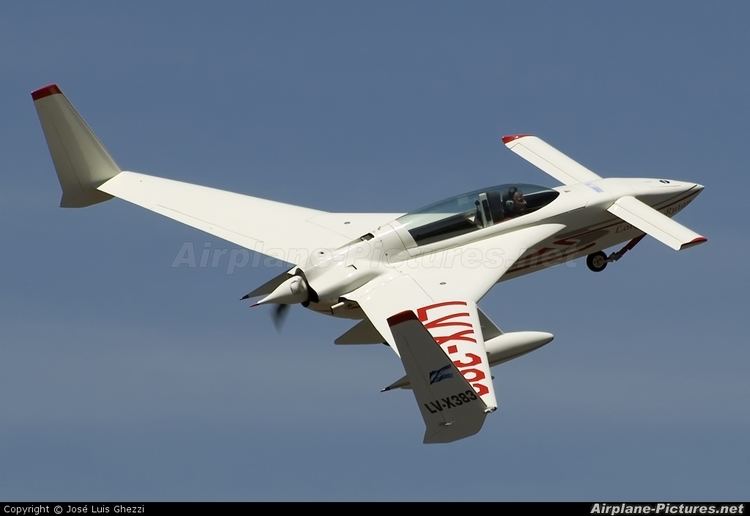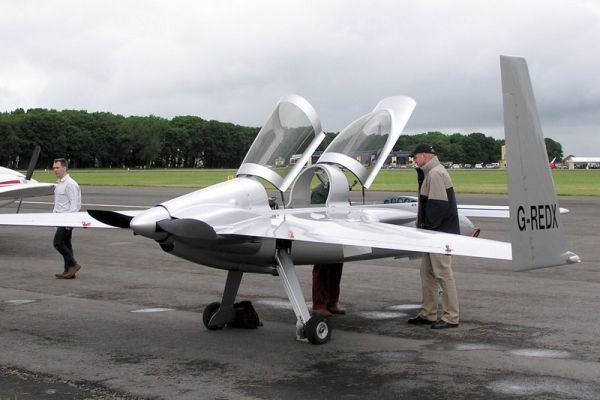Cruise speed 232 km/h Top speed 298 km/h Wingspan 7.96 m | Range 3,235 km Length 5.12 m Weight 322 kg | |
 | ||
Long ez first flight
The Rutan Model 61 Long-EZ is a homebuilt aircraft with a canard layout designed by Burt Rutan's Rutan Aircraft Factory. It is derived from the VariEze, which was first offered to homebuilders in 1976. The prototype, N79RA of the Long-EZ first flew on June 12, 1979.
Contents
- Long ez first flight
- Burt rutan long ez cross country flight jon berger long ez
- Design
- Operational history
- Variants
- Accidents and incidents
- Specifications
- References

Burt rutan long ez cross country flight jon berger long ez
Design

The Long-EZ was a clean-sheet scaled-up redesign of the VariEze predecessor. Changes from the VariEze included a larger main wing with modified Eppler 1230 airfoil and less sweep—the canard uses the same GU25-5(11)8 airfoil as the VariEze—larger strakes containing more fuel and baggage storage, slightly wider cabin, and the ability to use a Lycoming 108 hp engine with no nose ballast. Plans were offered from 1980 to 1985. As of late 2005, approximately 700 Long EZ's are FAA registered in the USA.

In January 1985, it was announced that plans for a new canard were being offered, to eliminate "rain trim change" that had been experienced by Long-EZ pilots. This trim change is usually a nose down trim change experienced when flying into rain requiring a small aft force on the stick to maintain altitude, which is easily trimmed out, using the bungee trim system. The new canard was designed with the Roncz R1145MS airfoil, which produces considerably more lift than the original GU25-5(11)8 airfoil. This enabled the new canard to be designed with less span, reducing wetted area and thus drag. The new canard has a negligible rain trim and the rain only adds 2 knots to the stall speed.

The aircraft is designed for fuel-efficient long-range flight, with a range of just over 2,000 miles (3,200 km). It can fly for over ten hours and up to 1,600 miles (2,600 km) on 52 gallons (200 liters) of fuel. Equipped with a rear-seat fuel tank, a Long-EZ has flown for 4,800 miles (7,700 kilometers).

The pilot sits in a semi-reclined seat and controls the Long-EZ by means of a side-stick controller situated on the right-hand console. In addition to having an airbrake on the underside, the twin tail's wing-tip rudders can be deflected outwards to act as auxiliary airbrakes.
In 1996 Burt Rutan awarded TERF Inc. the job of publishing the plans for the Long EZ and other of his aircraft under The Rutan Aircraft Factory CD ROM Encyclopedia for the purpose of further assisting new builders and maintenance for existing builders.
Operational history
In 1997 Dick Rutan and Mike Melvill flew two Long-EZ aircraft on an around-the-world flight. Some legs of this flight extended over 14 hours in the air.
Gloucester businessman Bill Alan converted his Long-EZ G-WILY for trans-oceanic flight, fitting luggage pods beneath the wings and a large extra fuel tank in lieu of a passenger seat.
Variants
Accidents and incidents
Singer-songwriter John Denver died when his Long-EZ crashed on October 12, 1997. The NTSB believes that he inadvertently pushed on his right rudder pedal while twisting to the left in his seat as he struggled to operate the fuel selector valve, which on his aircraft had been moved by a previous owner to a position where it could more easily be reached from the passenger seat. Contributing factors in the crash were other pilot errors, a design that led to an overly optimistic pre-flight fuel-check estimate, a known defective (very hard to turn) fuel valve, and non-standard placement of the fuel selector valve by the kit plane's builder, at variance with Burt Rutan's specs. Denver was aware of the relocated valve prior to take off and had previously flown the aircraft only for approximately thirty minutes in an orientation flight the day before the accident, although he was an experienced pilot. The NTSB cited Denver's unfamiliarity with the aircraft and his failure to have the aircraft refueled as causal factors in the accident. The aerodynamics of this unusual aircraft did not play a role in Denver's crash.
The author James Gleick crash-landed his Long-EZ at Greenwood Lake Airport, in West Milford, New Jersey in 1997. Gleick was seriously injured and the passenger, his 8-year-old son Harry, was killed.
Specifications
Data from Jane's All The World's Aircraft 1982–83
General characteristics
Performance
